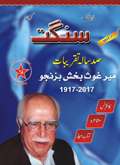TRIBUTE TO THE MEMORY OF YOUNG ANTHROPOLOGIST AND THE BALOCHOLOGY SCHOLAR, ROBERT NIEL PEHRSON
( 1926-1 955 )
By Ayub Baloch
Distinguished Anthropologist Alfred L. Kroeber once wrote ” Anthropology is the most humanistic of sciences and the most scientific of humanities “. Once that fascinating science touches your heart you hardly be anything but ensnared. It would be a life long affair. Same is true about Balochistan. To those interested in the study of continuity of societal development from Stone Age down to the contemporary times, Balochistan is a heaven. It offers numerous attractions to researchers including Nomadism, a lifestyle typical to Balochistan, that originated at Mehrgarh more than 9000 years ago and is being followed till today.
Some of the world-famed anthropologists studied Baloch nomads and gave the world very valuable accounts of the Baloch culture and society. Among them, not to name all but a few, included Professor Brian I. Spooner, Dr. Scholz, professor Steve Pastner, and of course, the youngest but very outstanding anthropologist Robert Neil Pehrson, who along with his wife Jean Pehrson studied the Marri Baloch . His book ‘Social Organisation of the Marri Baluch’ is one of the few books on Balochistan, being taught in various universities of the world even today.
Born in 1926, Robert Neil Pehrson was from Manitowac, Wisconsin, studies in the College of the University of Chicago, where he received his bachelor’s degree in 1948. While working initially as a sailor, he was attracted to anthropology and wanted to carry out research among nomads. He chose to study Lapps of Sweden. With the constant guidance of his professors, he remained with the Lappish nomads and earned a name even as a student. During his stay in Sweden, he also studied Anthropology at the University of Stockholm. On his return from Sweden, he joined University of Chicago for his Master’s Degree. After qualifying from there, he also taught for some time (1953-1954) in the college of the University of Chicago. Meanwhile he completed work on his Ph.D thesis ( which was awarded to him posthumously ). Despite his young age, he was already known in anthropological circles for his Lappish work and was a familiar name in nomadic studies.
Recognising his talent, Robert N. Pehrson was offered a fellowship by Ford Foundation (Overseas) to carry out studies in anthropology. It encouraged him to pursue his future goals, particularly in the nomadic spheres. By then he had developed an interest in Balochistan after interacting with scholars and reading their books who had impressively contributed in that respect. So he chose to go to Balochistan and study the Baloch nomads i.e the Marri Baloch.
Robert Pehrson and wife Jean Pehrson arrived in Balochistan for fieldwork in November 1954 and took up their research in mid-December that year. From March 1955, they lived and migrated with various camps of the Marri nomads. During this period he strictly followed one of the the key anthropological research methodologies, the ‘participant observer’. As Fredrik Barth maintained “he dedicated himself to ‘ becoming a Marri ‘ and participated in all tribal and camp activities”. He was given the local name of Bob Khan. Being quite sharp in learning languages, he could speak Balochi with considerable fluency. They dressed like Marri and were accepted as members of Marri Tribe, a distinction for which anthropologists in the field always long for. It showed how successful the couple was in winning the confidence of their hosts. There were accounts when Pehrsons took part in tribal feuds of the camps and whenever required as a gesture of solidarity picked up arms to defend the host camp. As Barth pointed out ” Perhaps he ran unnecessary risks by taking our teachers’s standards of participation more literally then they themselves have done.” ( please see the foreword of Pehrson’s book ).
While they were successfully carrying out research work, unfortunately Robert N. Pehrson died in the field after a short illness on September 8, 1955, at a very young age of 29 years. It was a big shock to Jean, to the hosts i.e Marri Tribe, to the anthropological fraternity internationally and particularly to the famous Norwegian anthropologist (Swat famed) Fredrik Barth who had been Pehrson’s mentor and guru in the discipline with whom he used to exchange views and sought help when he was faced with research problems. Then, Professor Barth was doing field work in Swat. Pehrson’s untimely death came as a devastating blow to the research project and there was every likelihood that it would be quashed without any tangible outcome. But luckily, with the resolve of Jean and the skills and distinctions of Professor Barth, it was appropriately rescued.
The monograph ‘Social Organisation of Marri Baluch’ was latter developed by Professor Fredrik Barth in the light of notes wrote by Pehrson and Jean. It is truly a world class document on Balochistan, revered by students and professionals belonging to the field of anthropology as well as Balochology. It is duly valued as a treasure literature on nomadism, quoted in numerous subsequent research works globally. As said earlier, it is included in the syllabus of almost all universities of the world that matter in teaching social organisation or nomadic culture.
To commemorate Robert Pehrson’s memory, Marri have erected a few bulky stones at Mir’s campsite where Robert died. He is buried there. Occasionally nomadic elders talk about the couple so that youngsters may know about them. Sometime sacrificial animals are slaughtered by nomads at the site to pay homage to Robert N. Pehrson, the Bob Khan Marri.
This brief note too, is intended to refresh his memory. It is an attempt to add a humble stone to the symbolic memorial site and pay tribute to a young anthropologist and a Balochology scholar.
 Sangat Academy Monthly Sangat Quetta
Sangat Academy Monthly Sangat Quetta
